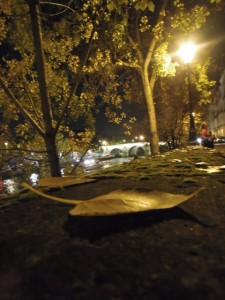 Sell your cleverness, buy bewilderment -Rumi
Sell your cleverness, buy bewilderment -Rumi
Ann breezed into the café at Rue Foumelle for our 4:00 consultation. She unbuttoned her overcoat, straightened her scarf, and sat. She carried the smell of crisp autumn leaves.
I got in my teacher-frame-of-mind, always slightly astonished to find myself in this position—as The Teacher–especially so with someone like Ann, who is a couple of decades older than me, who has trained airline pilots, and has a poise and an aura of kindness I aspire too. So often while Ann studied writing, I studied Ann.
What was it? Her perfectly tied scarf? Her posture? Her easy but sagely eye contact? She wasn’t blustery and loud. She didn’t dominate dinner tables, or command attention. Whatever it was, it couldn’t be mimicked. It was a presence. A subtle gravity that drew your attention like a whisper. Something earned.
We ordered hibiscus tea and I spread out my notes and got started. Ann lost her daughter to cancer several years ago and her essay was about a healing retreat on an island with her spiritual teacher. I wanted to impose order and flow on the first draft of her story.
I think it best if you reveal one spiritual lesson per section. I numbered each statement of revelation and circled the relevant text.
It was odd to reduce her enormous experience of grief into these perfunctory writing tips. But I was no psychologist and though I’ve had my share of losses—I trusted completely people who said that losing a child is that worst thing a person could go through. I wondered: What did I have to offer Ann, who had endured so much more? All I had were these tools of expression—the mechanics of sentence and sentiment. So, I continued.
And also, break down broad statements into smaller details.
This was key. First drafts are often fraught with words that bulge like overstuffed suitcase: Anger. Beauty. Happy. These words are too big and general.
Vivid writing is a trick of proportions. The writer has to get tiny and specific in order to communicate what is large and universal. As the saying goes, “God is in the details.”
And so rather than say “the man was handsome,” show us the arch of his brow, the low lilt of his voice. Don’t tell us you were fed up with urban living. Show us you hucking your iPhone at the IKEA lamp across the room while a loud delivery truck idled nonstop outside the window.
I circled the big general words in Ann’s essay and prescribed breaking them down into small specific images.
I buttoned my coat and stepped back out into the near-winter air. I crossed the bistro-lined rue and followed it over the choppy Seine toward Notre Dame. I’d passed the famed cathedral dozens of times, awed as anyone by the flying buttresses which, depending on the light, looked by turns beautiful or sinister. But I never did felt a particular need to go in, always too put off by the crowd outside the entrance.
But in that evening’s dimming light, there was an unusual sense of spaciousness outside, and an easy flow of people going through the front door which pulled at me like a brisk current. I left the hint-of-winter air and yielded. The atmosphere was full of hymns and incense. Mass was in session.
In just a few steps, I felt the sudden awe of taking that last step onto a mountain peak. Not a particularly religious sensation –in fact, it felt much bigger than religion. It was a rapping in the epicenter in my chest, a place sometimes stirred awake by poetry, or music: a grandeur that jars me and makes me realize that, in fact, I spend most of my waking life asleep.
I was happy to be there on my own with no brilliant and hilarious friend at my side to share whispering snarky invectives against religion, or running commentaries on the gothic architecture. Cathedrals, I realized, are best experienced alone.
I proceeded around the perimeter of the cathedral, past vignettes, past alcoves, past the transect, under the arches, past people lighting candles, people kneeled in prayer, people gazing up and felt myself in the presence of something very, very old and felt dwarfed not just by the cavernous arches, but by time, too—by the old incantations, mysterious, inscrutable, perennial, and hallowed, reaching through the ages to me right there in my tennis shoes.
In that resounding space, I felt myself a small detail, tiny but telling. This sense of proportion came to me as a relief–a break from the daily grind of trying to be Somebody. Like a specific piece of grass in a large field, I was a working part of a larger order, and humbled by a huge mystery.
I was small on the outside but big on the inside–right in the place where good writing comes from.
I completed my wander around the cathedral and in one step entered again the small mind of the street. My big hallowed self started dozing off to sleep, and soon I was smoothing my hair in a shop window and craving a glass of house red.
I thought of Ann’s grief, the size of it, and how it must constantly alter her own sense of scale. I thought of her calm presence which wasn’t I realized out of timidity or shyness, but sourced from an inner life as big as Notre Dame.
